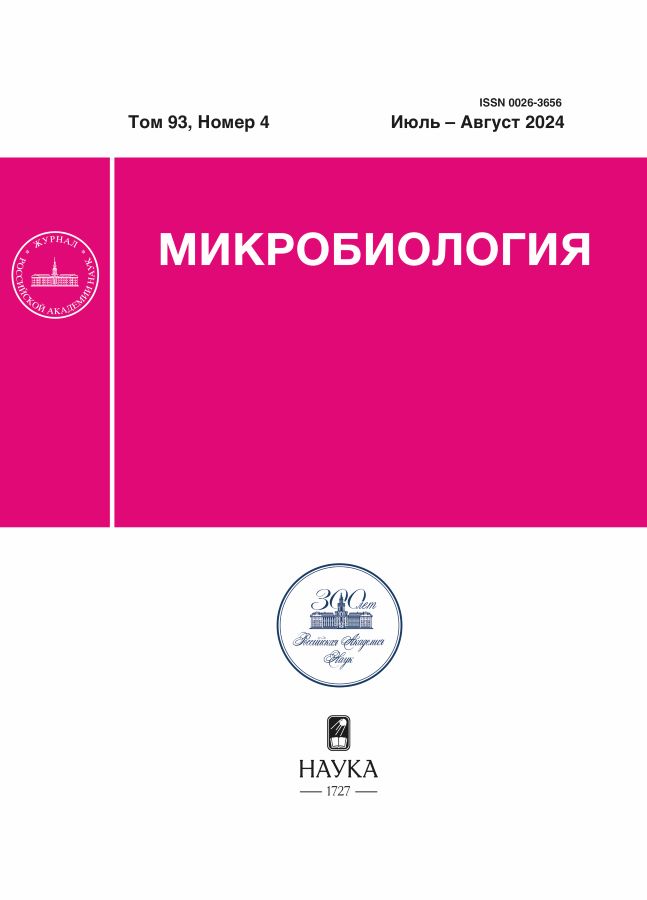Search for Bacteriophages Specific against Members of the Genus Rhodococcus
- Autores: Novikov A.D.1, Tokmakova I.P.1, Samarin A.A.1, Lavrov K.V.1, Yanenko A.S.1
-
Afiliações:
- NRC “Kurchatov Institute”, Kurchatov Genomic Center
- Edição: Volume 93, Nº 4 (2024)
- Páginas: 451-455
- Seção: SHORT COMMUNICATIONS
- URL: https://edgccjournal.org/0026-3656/article/view/655094
- DOI: https://doi.org/10.31857/S0026365624040084
- ID: 655094
Citar
Texto integral
Resumo
This is the first report on the isolation of Rhodococcus aetherivorans-specific bacteriophages and of applicability of such invertebrates as Hyalophora cecropia and Eisenia fetida as objects for screening the phage microflora of Rhodococcus species. Some of the isolated phages were capable of growth of R. ruber and R. qingshengii. An efficient procedure for bacteriophage reproduction in the liquid culture of R. aetherivorans was developed. The revealed bacteriophages may be used for development of efficient genetic tools for Rhodococcus strains, including the industrially significant ones.
Palavras-chave
Texto integral
Sobre autores
A. Novikov
NRC “Kurchatov Institute”, Kurchatov Genomic Center
Autor responsável pela correspondência
Email: alexm19@mail.ru
Rússia, 123182
I. Tokmakova
NRC “Kurchatov Institute”, Kurchatov Genomic Center
Email: alexm19@mail.ru
Rússia, 123182
A. Samarin
NRC “Kurchatov Institute”, Kurchatov Genomic Center
Email: alexm19@mail.ru
Rússia, 123182
K. Lavrov
NRC “Kurchatov Institute”, Kurchatov Genomic Center
Email: alexm19@mail.ru
Rússia, 123182
A. Yanenko
NRC “Kurchatov Institute”, Kurchatov Genomic Center
Email: alexm19@mail.ru
Rússia, 123182
Bibliografia
- Бактериофаги. Биология и практическое применение / Под ред. Э. Каттер, А. М. Сулаквелидзе. М.: Научный мир, 2012. 640 с.
- Bubnov D. M., Yuzbashev T. V., Khozov A. A., Melkina O. E., Vybornaya T. V., Stan G. B., Sineoky S. P. Robust counterselection and advanced λRed recombineering enable markerless chromosomal integration of large heterologous constructs // Nucleic Acids Res. 2022. V. 50. P. 8947–8960. https://doi.org/10.1093/nar/gkac649
- Grechishnikova E. G., Shemyakina A. O., Novikov A. D., Lavrov K. V., Yanenko A. S. Rhodococcus: sequences of genetic parts, analysis of their functionality, and development prospects as a molecular biology platform // Crit. Rev. Biotechnol. 2023. V. 43. P. 835–850. https://doi.org/10.1080/07388551.2022.2091976
- Guzman J., Vilcinskas A. Draft genome sequence of Rhodococcus rhodochrous strain G38GP, isolated from the Madagascar hissing cockroach // Microbiol. Resour. Announc. 2021. V. 10. Art. e0077721. https://doi.org/10.1128/MRA.00777-21
- Kim D., Choi K. Y., Yoo M., Zylstra G. J., Kim E. Biotechnological potential of Rhodococcus biodegradative pathways // J. Microbiol. Biotechnol. 2018. V. 28. P. 1037–1051. https://doi.org/10.4014/jmb.1712.12017
- Larkin M. J., Kulakov L. A., Allen C. C. Biodegradation and Rhodococcus – masters of catabolic versatility // Curr. Opin. Biotechnol. 2005. V. 16. P. 282–290. https://doi.org/10.1016/j.copbio.2005.04.007
- Liang Y., Jiao S., Wang M., Yu H., Shen Z. A CRISPR/Cas9-based genome editing system for Rhodococcus ruber TH // Metab. Engin. 2020. V. 57. P. 13–22. https://doi.org/10.1016/j.ymben.2019.10.003
- Liang Y. X., Yu H. M. Genetic toolkits for engineering Rhodococcus species with versatile applications // Biotechnol. Adv. 2021. V. 49. Art. 107748. https://doi.org/10.1016/j.biotechadv.2021.107748
- Martinkova L., Uhnakova B., Patek M., Nesvera J., Kren V. Biodegradation potential of the genus Rhodococcus // Environ. Int. 2009. V. 35. P. 162–177. https://doi.org/10.1016/j.envint.2008.07.018
- Salcedo-Porras N., Umana-Diaz C., de Oliveira Barbosa Bitencourt R., Lowenberger C. The role of bacterial symbionts in triatomines: an evolutionary perspective // Microorganisms. 2020. V. 8. Art. 1438. https://doi.org/10.3390/microorganisms8091438
- Summer E. J., Liu M., Gill J. J., Grant M., Chan-Cortes T.N., Ferguson L., Janes C., Lange K., Bertoli M., Moore C., Orchard R. C., Cohen N. D., Young R. Genomic and functional analyses of Rhodococcus equi phages ReqiPepy6, ReqiPoco6, ReqiPine5, and ReqiDocB7 // Appl. Environ. Microbiol. 2011. V. 77. P. 669–683. https://doi.org/10.1128/AEM.01952-10
- Yassin A. F. Rhodococcus triatomae sp. nov., isolated from a blood-sucking bug // Int. J. Syst. Evol. Microbiol. 2005. V. 55. P. 1575–1579. https://doi.org/10.1099/ijs.0.63571-0
- Патент СССР. 1990. № SU1731814.
- Патент США. 2014. № US20140187818A1.
Arquivos suplementares










